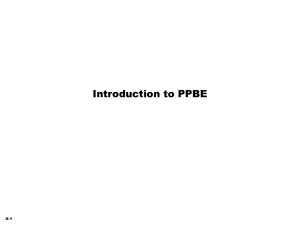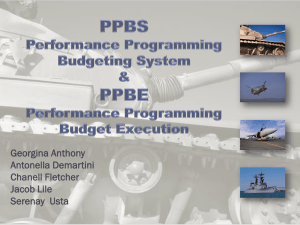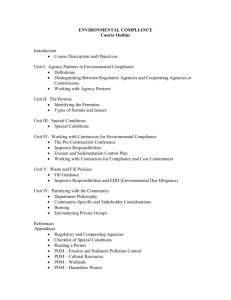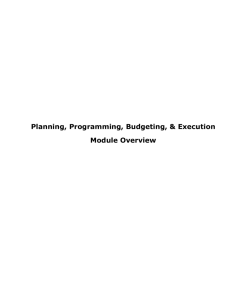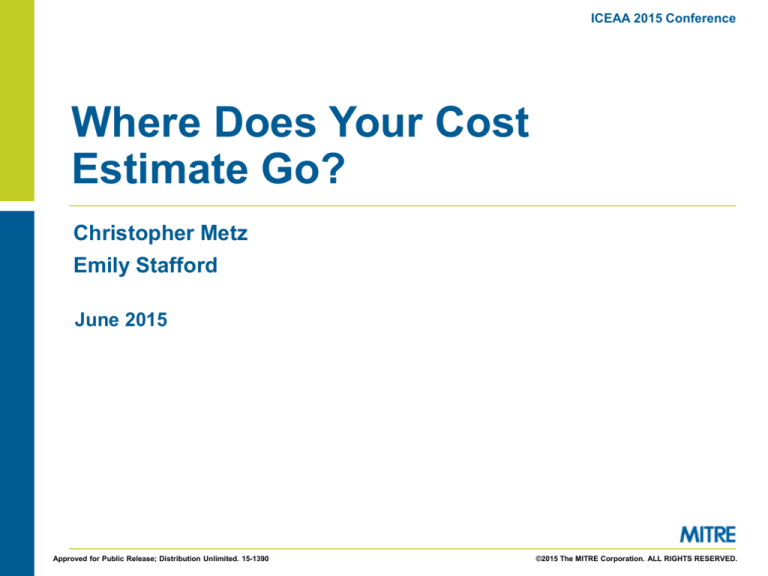
ICEAA 2015 Conference
Where Does Your Cost
Estimate Go?
Christopher Metz
Emily Stafford
June 2015
Approved for Public Release; Distribution Unlimited. 15-1390
©2015 The MITRE Corporation. ALL RIGHTS RESERVED.
|2|
Agenda
Objective
Background
Role of Cost Estimating versus Budgeting
Planning, Programming, Budgeting, and Execution
(PPBE) Process and the Cost Estimate
Other Considerations
Other Places a Cost Estimate Goes
Discussion/Questions
|3|
Objective
Track what happens to a Program Office cost estimate (POE)
after it has been developed and delivered
– Follow the estimate through the budget formulation process,
ultimately becoming a part of the President’s Budget
Highlight the real world application of the cost estimates:
– Why are they so valuable?
– How are they utilized?
Discuss the importance of the cost estimator’s role during the
budget process, and the influence of the budget process on
future estimates
– Highlight cost estimating best practices and lessons learned that
take into account an understanding of the budget process
|4|
Background
Most cost analysts spend 6-18 months supporting the
development of a cost estimate within a program office
– This is best done when cost analysts work as an integral member
of the program’s systems engineering team
Key application of a cost estimate is to establish and defend the
budget, but costs analysts rarely stay involved after delivering
the cost estimate
The development of the Program Objective Memorandum (POM)
and Budget Estimate Submission (BES) within the Planning,
Programming, Budgeting and Execution (PPBE) process is
usually handled by budget analysts
|5|
Cost versus Budget Role
Cost analysts develop the program’s cost estimate and analyze the
estimate’s risks, uncertainties, and sensitivities.
Associate Resources
with Funding Lines
Determine Resources
Intra-program
Program
Management
Develop a
realistic riskadjusted cost
estimate
Utilize cost
data
Programmatic
Execution
Program Management
Intra-program
Programmatic
Planning
Cost
Budget
Budget analysts focus on where and how the funds should be spent.
|6|
Use of Cost Estimate
Experience shows there is a spectrum over which the cost
estimate is used in the budget process
Use of Program Office Cost Estimate in Budget
Program Office lacks a
robust cost estimating
team and/or the value of
cost estimate is not
understood
Lack of coordination
between the budget
analysts and cost analysts
could result in a
misunderstanding of the
cost estimate
Coordination and
collaboration between the
budget analysts and cost
analysts result in a budget
that reflects the insights of
the cost estimate
Budget submissions
informed only by
previous year’s
spending
Budget submissions
take into account
delivered cost
estimate
Budget submissions
are informed by and
accurately reflect the
cost estimate
Often the cost estimate is not effectively utilized.
|7|
PPBE Process Review
The PPBE process is the primary resource management system
for the DoD:
– Articulates strategy
– Identifies size, structure, and equipment for military forces
– Sets programming priorities
– Allocates resources
– Evaluates actual output against planned performance and adjusts
resources as appropriate
A better understanding of the budget process is beneficial to the
development of cost estimate realism.
|8|
Cost Estimate in the PPBE Process
Programming and Budgeting
Cost
Budget
Planning
Strategic
Planning
Guidance
Development
Program
Objective
Memorandum
(POM)
DPG
Budget
Estimate
Submission
(BES)
POE
Develop Cost
Estimate and Cost
Risk Estimate
Execution
Feedback,
Commitment,
Obligation,
Expenditure
President’s
Budget
Congressional
Enactment
Update cost
estimate to
support next
PPBE cycle
Roles of cost analysts and budget analysts are different, but the
two should collaborate and coordinate their final products during
the Programming and Budgeting phases of the PPBE Process.
DPG – Defense Planning Guidance
POE – Program Office Estimate
|9|
Cost Estimate Development
Programming and Budgeting
Budget
Planning
Strategic Planning
Guidance
Development
Program
Objective
Memorandum Program
(POM)
Objective
President’s
Memorandum
Budget
Budget
Cost
POE
Develop Cost
Estimate and
Cost Risk
Estimate
POE
Estimate
Submission
(BES)
1. Develop Programmatic &
Technical Baseline
2. Develop estimate using standard
practices
3. Conduct uncertainty & risk
analysis
4. Present results to Program Office
5. Consider estimate against
Program constraints
6. Update estimate and results in
POE
(POM)
Execution
Feedback,
Commitment,
Obligation,
Expenditure
FTE – Full Time Equivalent
WBS – Work Breakdown Structure
POE – Program Office Estimate
Congressional
Enactment
Update cost
estimate to
support next
PPBE cycle
Best practices for cost estimate to be more
valuable to the budget
• Detailed near-term considerations to trace
funding for budget year
• Ability to break out estimate based on
funding source and timeline
• Civilian FTEs and Military Manpower funding
should be tracked separately
• Detailed insight into specific WBS elements
as required by known taskers
| 10 |
Programming & Budgeting
Programming and Budgeting
Budget
Planning
Strategic Planning Guidance
Development
Program
Objective
Memorandum
(POM)
Cost
DPG
Develop Cost Estimate and
Cost Risk Estimate
POE
Budget Estimate
Submission
(BES)
Joint Staff/CAPE Analysts Questions
- What is included in the estimate in the
FYDP and across the life cycle?
- How does the current mission estimate
compare with previous mission estimate?
Execution
Feedback,
Commitment,
Obligation,
Expenditure
President’s
Budget
Congressional
Enactment
Update cost
estimate to support
next PPBE cycle
OMB Analysts Questions
- SNAP Test & Evaluation
- OMB 300 (FTEs)
- Project Description
Sheets (PDS)
Coordination and collaboration with the budget analysts to justify inputs
by connecting programming and budgeting to the cost estimate.
CAPE – Cost Assessment and Program Evaluation
FYDP – Future Years Defense Program
SNAP - Select and Native Programming (Data Input System)
OMB – Office of Management & Budget
| 11 |
Congressional Enactment
Programming and Budgeting
Budget
Planning
Strategic Planning
Guidance Development
DPG
Program
Objective
Memorandum
(POM)
Cost
Budget Estimate
Submission
(BES)
Feedback,
Commitment,
Obligation,
Expenditure
President’s
Budget
Congressional
Enactment
Develop Cost POE
Estimate and Cost
Risk Estimate
Budget Resolution:
HBC/SBC
Execution
Update cost
estimate to
support next PPBE
cycle
Authorizations:
HASC/SASC
Appropriations:
HAC/SAC
Examples of cost information requested by the committees:
- Life Cycle Cost Estimate (LCCE) by Fiscal Year
- Pie chart by cost element
- LCCE mapped to Spend Plan
- Mapping of LCCE to milestones in Budget Year
During Congressional Enactment, House and Senate Committees may
request additional details on cost, schedule, and performance.
HBC – House Budget Committee
SBC – Senate Budget Committee
HASC – House Armed Services Committee
SASC – Senate Armed Services Committee
HAC – House Appropriations Committee
SAC – Senate Appropriations Committee
| 12 |
PPBE Timeline
CY20X0
CY20X1
CY20X2
J F M A M J J A S O N D J F M A M J J A S O N D J F M A M J J A S O N D
Execution: 2nd Year
Execution: 3rd Year
Execution: FYX1 & prior
Execution: 2nd Year
3rd
Execution: FYX2 & prior
2nd
Execution: FYX0 & prior
PB
FYX1 Enactment
Planning
FYX2-X6
DPG
Program & Budget
FYX2-X6 POM
FYX2 BES
Planning
FYX3-X7
DPG
Cost estimate update may be required
P
B
FYX2 Enactment
Program & Budget
FYX3-X7 POM
FYX3 BES
P
B
Planning
FYX4-X8
DPG
Enactment: FYX3
Program &
Budget
FYX4-X8 POM
FYX4 BES
The phases of the PPBE process occur in parallel as budgets for the
current year and future years are planned and developed.
DPG – Defense Program Guidance POM – Program Objective Memorandum
PB – President’s Budget
BES – Budget Estimate Submission
CY – Current Year
FY – Fiscal Year
Exec:
FX3 &
prior
| 13 |
Other Considerations
Consideration
Impacts
-
Independent Cost Estimate (ICE)
-
Issue Paper Process
Budget Constraints during
Execution
Cost Estimate information to
Congress vs. DoD
Non-DoD Budget Process
-
An ICE provides a level of assurance that there is concurrence and
legitimacy in the cost estimate (i.e., budget estimate).
Budget submissions should be consistent with the ICE when required.
Issue Papers address a specific funding issue in the Programming
(POM) process
Justification will demand greater visibility due to sacrifices made in the
process
-
Congressional earmarks on funding are one way Congress ensures its
questions are answered in a timely manner and its objectives are
seriously considered
-
Keep in mind your audience when preparing results slides
-
Intelligence Community has a similar process to the PPBE called the
IPPBE
Other agencies follow similar timelines for budget submissions
Impact and role of the cost estimate should not differ in other agencies
-
These occur at various stages of the PPBE process, and have an impact on
the final cost estimate and, thus, the budget.
| 14 |
Other Places a Cost Estimate Goes
Economic
Analysis
Lease vs. Buy
Studies
CAIV Studies
Systems Engineering
Design Trade Studies
Cost
Estimate
Should
Cost/Will Cost
Analysis
Analysis of
Alternatives
Business Case
Analysis
Cost Benefit
Analysis
A cost estimate has many other useful applications in addition to
establishing and defending the budget.
CAIV – Cost As an Independent Variable
| 15 |
Conclusion
Cost estimates are a critical
component to systems
engineering and the budget
planning and execution
processes
.
Executable program
Coordination & Collaboration
Defendable budget
– A risk-adjusted estimate developed
to provide the right level of detail
helps to establish a defendable
budget and an executable program
Cost analysts should be a part
of the budget process and
invested in the outcome of the
cost estimate
Cost
Budget
| 16 |
Discussion/Questions
| 17 |
Acronym List
BES – Budget Estimate Submission
CAIV – Cost As an Independent
Variable
CAPE – Cost Assessment and
Program Evaluation
CY – Current Year
DPG – Defense Planning Guidance
FTE – Full Time Equivalent
FY – Fiscal Year
FYDP – Future Years Defense
Program
HAC – House Appropriations
Committee
HASC – House Armed Services
Committee
HBC – House Budget Committee
Independent Cost Estimate – ICE
LCCE – Life Cycle Cost Estimate
OMB – Office of Management &
Budget
PB – President’s Budget
PDS – Project Description Sheet
POE – Program Office Cost Estimate
POM – Program Objective
Memorandum
PPBE – Planning, Programming,
Budgeting, and Execution
SAC – Senate Appropriations
Committee
SASC – Senate Armed Services
Committee
SBC – Senate Budget Committee
SNAP – Select and Native
Programming (Data Input System)
WBS – Work Breakdown Structure


